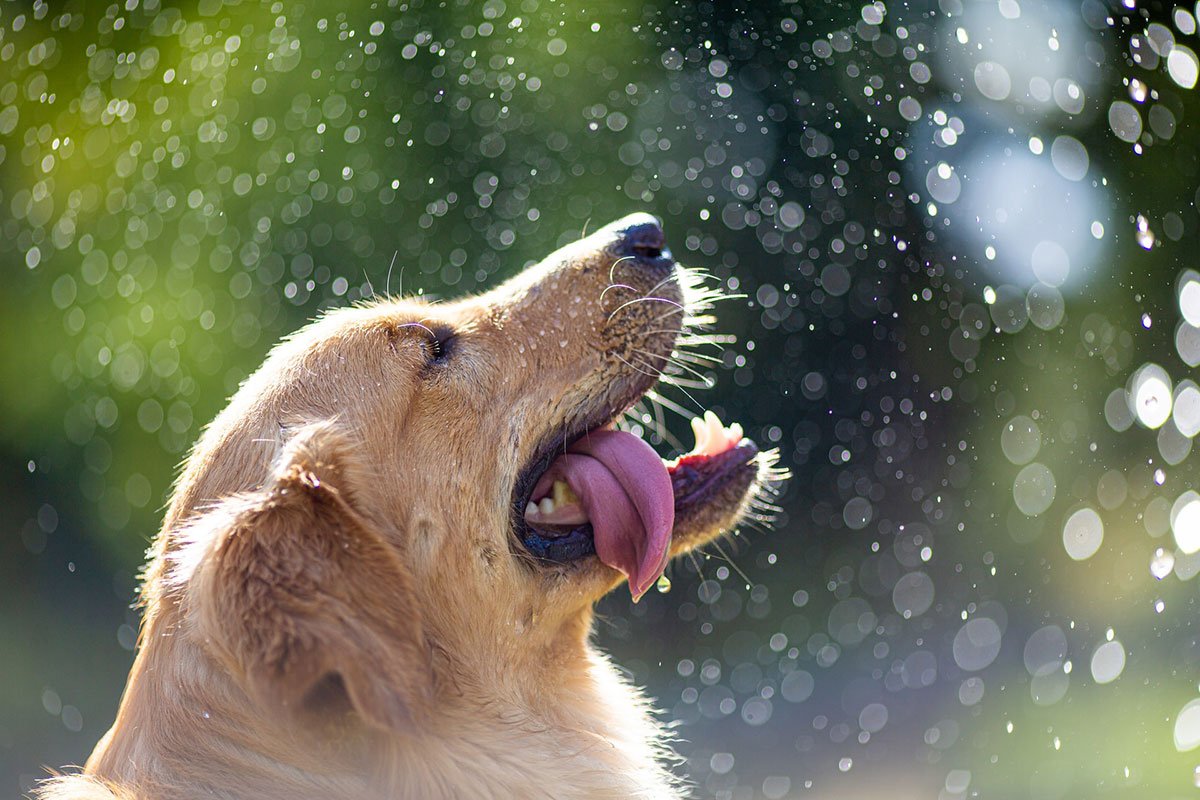We love our pets for the joy and companionship they bring. But training them can seem tough. That’s when we found positive reinforcement training. It changed how we interact with our pets and deepened our bond.
Imagine training that feels like a dance with your pet. Every lesson is a celebration, and every success is met with joy. Positive reinforcement training makes this a reality, and we’re excited to share it with you.
Key Takeaways
- Positive reinforcement training is a powerful and effective method for training dogs and other pets.
- By using rewards and encouragement, this approach helps create a positive association between desired behaviors and favorable outcomes.
- Positive reinforcement training leads to a well-behaved, happy, and confident animal companion.
- The training process becomes a harmonious dance between pet owner and pet, fostering a stronger bond.
- Positive reinforcement training is an animal-friendly and humane approach to training, prioritizing the well-being of the pet.
Unleashing the Power of Positive Reinforcement Training
Positive reinforcement training is a kind and effective way to train pets. It uses operant conditioning to help pets learn and grow. This method builds a strong bond between pets and their owners through reward-based learning.
Understanding the Principles of Operant Conditioning
Operant conditioning helps animals learn by linking actions to outcomes. In pet training, we focus on positive reinforcement. We reward good behavior to make it happen more often. This method is better and kinder than old ways that use punishment or fear.
The Benefits of Reward-Based Learning
Clicker training and other motivational training make pets learn quicker and bond stronger with us. This humane training way improves pets’ happiness and lets us work together without stress.
| Benefits of Reward-Based Learning | Traditional Training Methods |
|---|---|
| Faster learning and higher engagement | Slower learning and potential stress |
| Stronger bond between pet and owner | Strained relationship and fear-based behaviors |
| Positive, stress-free environment | Punishment-based and potentially harmful |
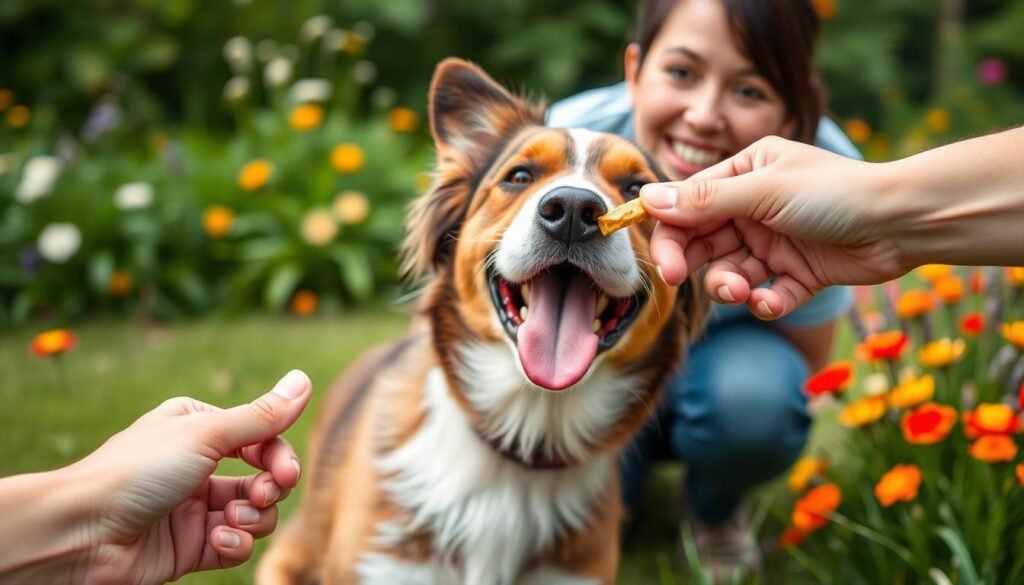
“Positive reinforcement training is a powerful tool that allows us to collaborate with our pets in a stress-free, enjoyable environment. By understanding the principles of operant conditioning, we can unlock the true potential of our furry companions.”
Clicker Training: A Game-Changer for Animal Companions
Clicker training is a game-changer in how we train our pets. It uses a small device that makes a clicking sound. This helps us mark the exact moment our pet does what we want, making communication clear and effective.
The magic of clicker training is the instant feedback it gives pets. When we click, we tell them they did something right. This makes them more likely to do it again. It’s based on operant conditioning and is a key part of animal-friendly training.
Clicker training makes learning stress-free. It focuses on rewarding good behavior, not punishing bad. This builds a strong bond and lets pets learn at their own pace. It’s a force-free training method that makes training better and keeps pets happy.
| Benefits of Clicker Training | Comparison to Traditional Training Methods |
|---|---|
|
|
Exploring clicker training shows it’s a big change in animal training. It’s a marker training method that’s changing the game. By using this animal-friendly method, we can help our pets reach their full potential. This creates a better, more rewarding relationship for both pets and their owners.
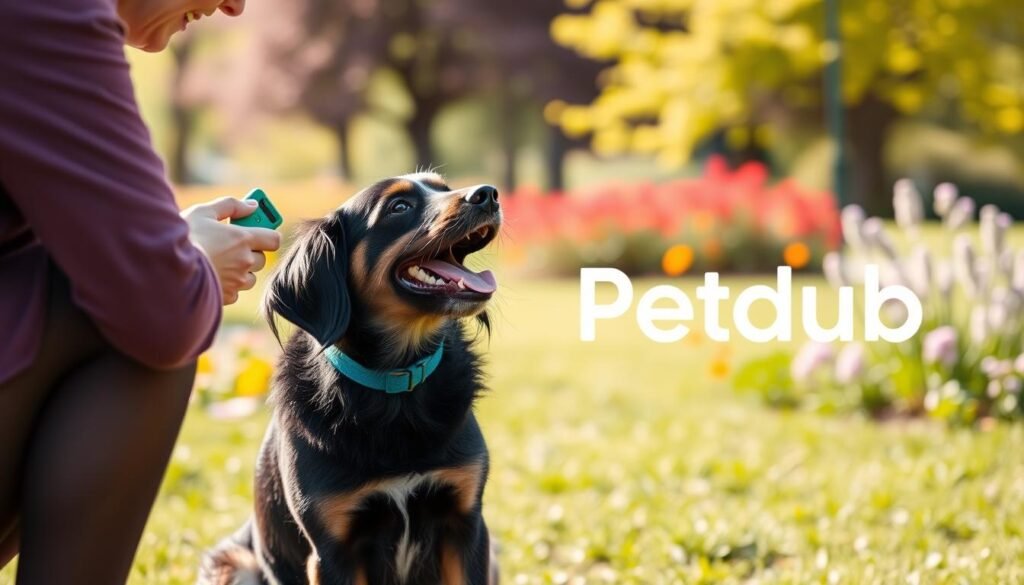
Fostering a Stress-Free Learning Environment
Creating a safe and motivating space is key for positive reinforcement training. A stress-free and fear-free learning environment helps our pets succeed and thrive.
Crafting a Positive and Motivating Space
To create a motivating environment for our pets, we need to focus on a few things. The training area should be free from distractions and stress sources. This means no loud noises, unfamiliar sights, or overwhelming smells.
It’s also important to make the training space animal-friendly and comfy. Soft surfaces, cozy bedding, and familiar toys help our pets feel at ease. This makes them more open to positive reinforcement techniques.
“The key to successful positive reinforcement training is to create a safe, stress-free, and rewarding environment for our beloved pets.”
By following these steps, we can create a motivating environment for our pets. Their comfort and well-being are our top priority. This way, we build a strong bond and a foundation for stress-free training.
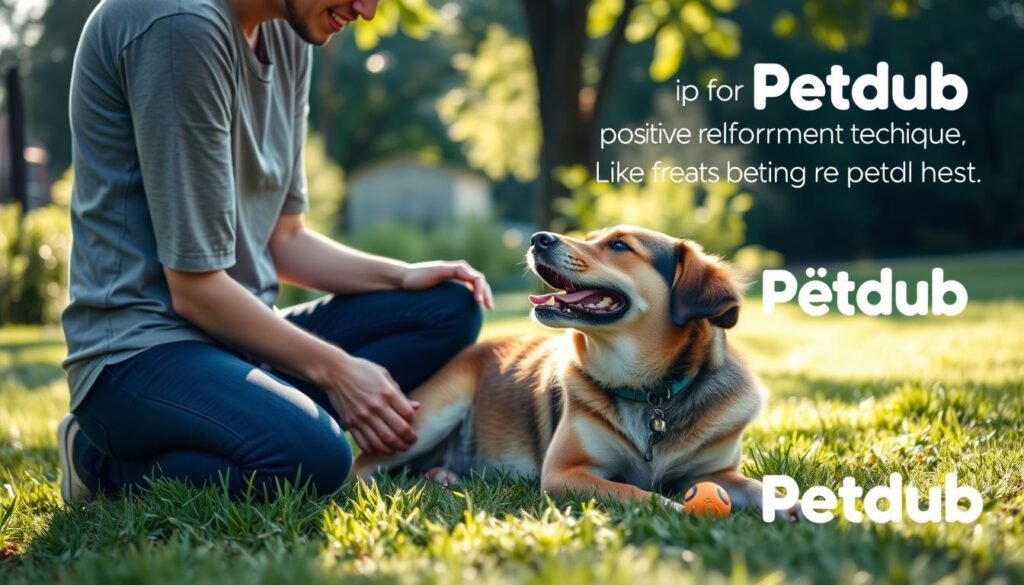
Positive Reinforcement Training: A Pawsitive Approach
At the heart of positive reinforcement training lies a powerful truth: rewarding desired behaviors is far more effective than punishing undesirable ones. This animal-friendly approach, also known as reward-based training, focuses on building a strong bond between pet and owner. It uses treats, praise, and other positive reinforcements.
By shaping our pet’s behavior with these positive reinforcement training techniques, we can create a happy, well-adjusted companion. They become eager to learn and please. This humane training method not only enhances the learning process but also fosters a deep sense of trust and mutual understanding.
“Positive reinforcement training is the most effective and humane way to train animals. It’s a win-win for both the pet and the owner.”
The beauty of positive reinforcement training lies in its simplicity. By rewarding desirable behaviors with treats or praise, we reinforce those actions. This reward-based training approach is not only effective but also empowering. Our pets learn that they have the ability to control the outcome and earn the rewards they desire.
As we embark on this animal-friendly training journey with our pets, we’ll discover the profound impact it can have on our relationship. By fostering a positive and stress-free learning environment, we’ll cultivate a deeper bond. We’ll unlock our furry friend’s full potential.
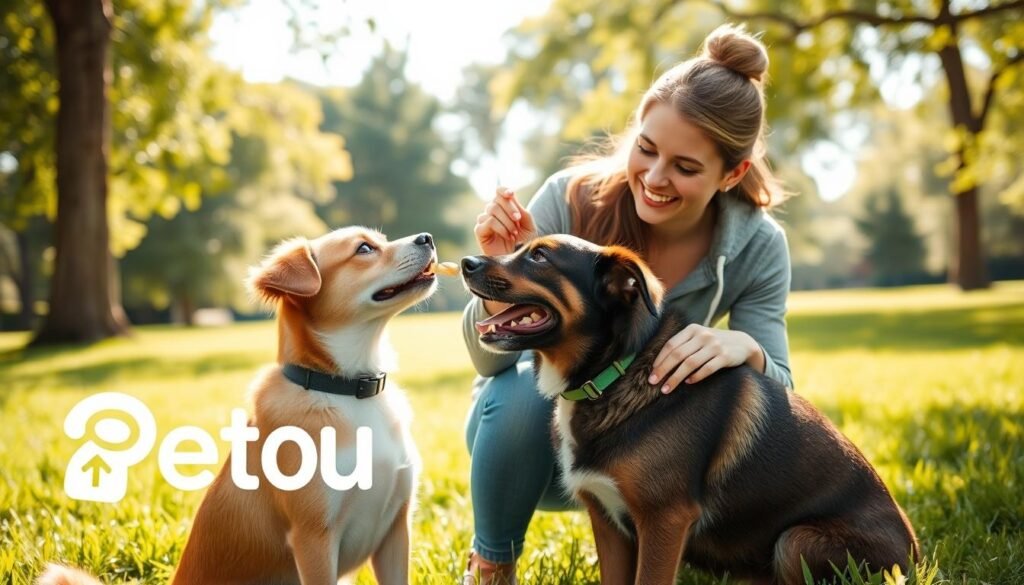
Mastering the Art of Marker Training
Marker training, or clicker training, is a big deal in positive reinforcement. It lets us tell our pets exactly when they do something right. This makes learning more precise and effective.
Timing is Everything: Capturing the Moment
The success of marker training depends on timing. A clear marker signal, like a click or a word, tells our pets they’re on the right track. This creates a direct link between their actions and the rewards they get.
Let’s say you’re teaching your dog to sit. The moment their bottom touches the ground, they know they’ve done it right. Then, the treat or praise they get makes that action even more appealing. This quick feedback is key to operant conditioning, the science behind reward-based training.
Learning to use the marker at the right time helps us teach our pets complex behaviors. It’s all about shaping their learning step by step. Whether it’s a new trick or a good behavior, this method builds a strong, positive connection with our pets.

“Marker training is a powerful tool that allows us to communicate with our pets in a clear, positive, and effective way. By capturing the moment of desired behavior, we can build a strong foundation for learning and strengthen the bond we share with our animal companions.”
As we explore marker training further, we’ll learn its core principles. We’ll see how it can change the way we train our pets. And we’ll find out how to make it a part of our daily lives with our furry friends.
Building a Strong Bond with Your Furry Friend
Positive reinforcement training is more than just teaching tricks. It’s about building a strong bond between you and your pet. Using rewards and encouragement makes learning fun and strengthens your relationship.
Engaging in bond with pet through positive reinforcement training teaches new skills and builds trust. This reward-based learning makes pets eager to learn and enjoy spending time with you.
Creating an animal-friendly training environment deepens your connection with your pet. Focus on praise, treats, and playtime as rewards. This approach keeps your pet happy and well while strengthening your bond.
- Prioritize positive reinforcement: Reward your pet’s desired behaviors with treats, affection, and enthusiastic praise.
- Engage in fun, interactive training sessions: Incorporate play and games to make the experience enjoyable for both you and your pet.
- Maintain a calm and patient demeanor: Your pet will respond better to a gentle, reassuring approach.
- Celebrate small victories: Recognize and reward your pet’s progress, no matter how small, to build their confidence and motivation.
By using positive reinforcement training, we can create a strong bond with our pets. Together, they learn new skills and see us as trusted friends and partners.
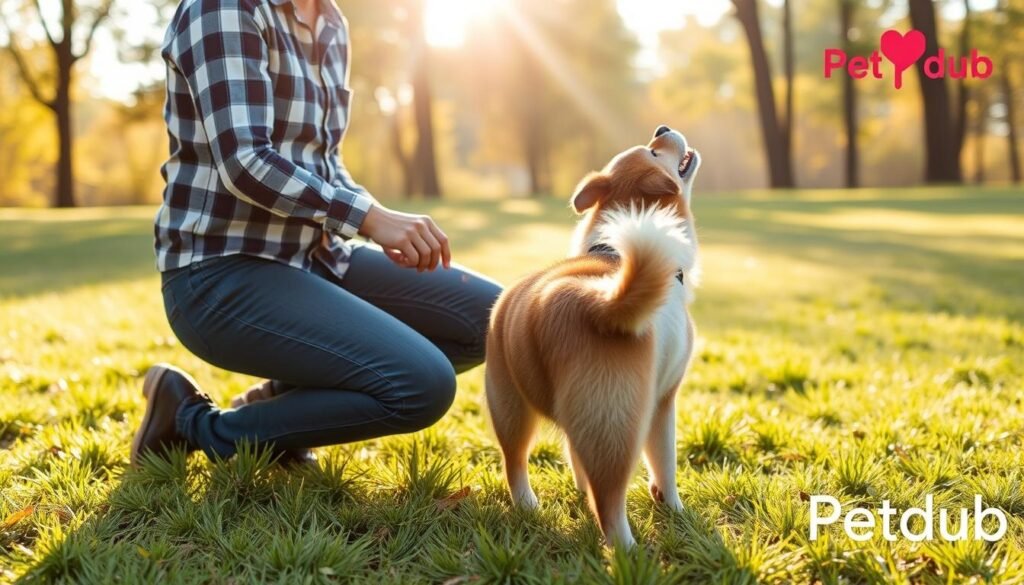
“The greatest gift we can give our pets is the bond of trust and understanding that comes from positive reinforcement training.”
| Positive Reinforcement Training | Traditional Training Methods |
|---|---|
| Builds a strong, trusting bond with your pet | May create fear and anxiety in your pet |
| Relies on rewards and encouragement | Relies on punishment and aversive techniques |
| Promotes eager, willing participation in training | May result in passive, reluctant compliance |
| Ensures a stress-free, enjoyable learning experience | Can lead to a stressful, uncomfortable training environment |
Overcoming Common Challenges in Positive Reinforcement Training
Positive reinforcement training is a great way to train our dogs. But, it comes with its own set of challenges. One big one is dealing with distractions and keeping our pets focused during training.
Distractions can be anything from loud noises to our pets’ natural curiosity. To beat these challenges, we need to create a focused and reward-based training environment.
- First, figure out what distractions bother your pet the most. Then, slowly get them used to these things through training.
- Use positive reinforcement training, like clicker training, to make your pet link good behavior with rewards. This keeps them motivated.
- Keep training sessions short and fun. This helps keep your pet’s attention and prevents boredom.
By tackling these common challenges, we can keep our positive reinforcement training on track. With patience, consistency, and a calm learning space, we can help our pets reach their full potential. This strengthens our bond with them.
Maintaining Focus Amidst Distractions
Keeping our pets focused is key to successful positive reinforcement training. We can do this by understanding and tackling the distractions that get in the way. This way, we can keep them engaged and eager to learn.
| Challenge | Potential Solution |
|---|---|
| Environmental Distractions | Train in a quiet place and slowly add distractions while rewarding focus. |
| Intrinsic Motivations | Use your pet’s interests in training to keep them interested. |
| Boredom or Fatigue | Make training sessions shorter and more varied to keep your pet excited. |
“Positive reinforcement training is not only effective, but it also strengthens the bond between the pet and the owner. By addressing common challenges and adapting our approach, we can unlock our furry friends’ full potential.”
Incorporating Positive Reinforcement into Daily Routines
Positive reinforcement training isn’t just for formal sessions. It can be part of our pets’ daily lives. This way, we can encourage good behavior all day. It also strengthens our bond with our pets.
By using positive reinforcement training during meals, grooming, and play, we teach our pets valuable lessons. For instance, giving treats or praise for waiting patiently or stepping onto the grooming table. It makes these actions more desirable.
Adding reward-based learning to playtime makes it fun for both of us. It encourages our pets to play and learn new tricks. This approach turns training into a positive experience.
Teaching pets cues like “sit” or “come” is another great strategy. It boosts their obedience and helps keep them safe. Making animal-friendly training a part of our daily routines increases their confidence and cooperation.
“Incorporating positive reinforcement into our pet’s daily life is a powerful way to reinforce desired behaviors and strengthen the bond we share.”
Consistency is key in positive reinforcement training. Regularly practicing it in our daily routines helps our pets thrive. It also makes our bond stronger with each positive interaction.
The Humane and Animal-Friendly Way of Training
Training our pets is a big responsibility. We must make sure they are happy and respected. Positive reinforcement training is key. It works well and is kind to animals.
Ethical Considerations in Reward-Based Learning
Positive reinforcement training uses rewards to teach good behavior. It’s better than punishment or fear. This way, pets learn without stress.
- It makes training fun and builds a strong bond with our pets.
- This method is kind and respectful to animals during training.
- It’s not just good for pets but also for us as caring owners.
Choosing force-free training is the best choice. It helps our pets reach their best and builds a strong bond with us.
“The true measure of a society can be found in how it treats its most vulnerable members.”
By focusing on reward-based learning, we make sure training is kind and good for our pets. This makes their lives better and more fulfilling.
Motivational Training: Unlocking Your Pet’s Potential
Positive reinforcement training is a powerful tool for unlocking our pet’s full potential. By understanding their individual motivations and using rewards that truly resonate with them, we can inspire them to learn, grow, and excel. This results in a well-trained, confident, and happy companion.
At the heart of motivational training lies the principle of positive reinforcement. This animal-friendly training approach focuses on rewarding desirable behaviors, rather than punishing unwanted ones. By tapping into our pet’s natural desires and preferences, we create a learning environment that is both enriching and enjoyable for them.
One of the key benefits of reward-based training is that it strengthens the bond between us and our furry friends. As we work together to achieve training goals, we build trust, communication, and a deeper understanding of each other’s needs and behaviors. This fosters a sense of teamwork and collaboration that benefits both the pet and the owner.
| Benefits of Motivational Training | Improved Pet Behavior |
|---|---|
| Enhances the pet-owner bond | Increased focus and attention |
| Promotes positive learning experiences | Reduced stress and anxiety |
| Unlocks the pet’s full potential | Better problem-solving skills |
By harnessing the power of motivational training, we can unlock our pet’s true potential. We create a rewarding, stress-free learning environment that benefits both the pet and the owner. Through patience, consistency, and a deep understanding of our furry companion’s unique needs, we embark on a journey of growth, discovery, and endless possibilities.
“The key to unlocking your pet’s potential lies in understanding their individual motivations and using rewards they truly value.”
Celebrating Milestones and Tracking Progress
In the world of positive reinforcement training, celebrating our pet’s progress is key. By recognizing and rewarding even the smallest achievements, we reinforce good behaviors. This boosts our pet’s confidence and keeps us both motivated.
Tracking progress helps us feel accomplished and ensures our training is working. Every milestone, from mastering a new command to showing enthusiasm for learning, is worth celebrating.
Recognizing and Rewarding Small Victories
In reward-based learning, small steps can lead to big strides. Acknowledging our pet’s progress, no matter how small, reinforces positive behaviors. This strengthens our bond and creates a positive reinforcement training environment where both pet and owner thrive.
- Celebrate your pet’s achievements, no matter how small, to build confidence and encourage continued learning.
- Use a variety of positive reinforcements, such as treats, praise, or playtime, to reward your pet’s efforts.
- Create a visual tracking progress system, such as a progress chart or milestone board, to help you and your pet stay motivated.
By celebrating milestones and tracking progress in our positive reinforcement training journey, we strengthen our bond with our pets. This rewarding approach to training unlocks their full potential. It ensures that both pet and owner can enjoy the process and celebrate their shared successes.
“Positive reinforcement training is not just about teaching new skills; it’s about building a trusting relationship and celebrating every step of the way.”
| Milestone | Reward | Date Achieved |
|---|---|---|
| Sit on command | Favorite treat | June 15, 2023 |
| Stay for 30 seconds | Playtime | July 1, 2023 |
| Walk calmly on leash | Praise and petting | August 10, 2023 |
Pet Monitoring Devices: Keep an Eye on Your Furry Friends
Conclusion
As we wrap up our look at positive reinforcement training, we see its amazing impact. It changes how we connect with our pets. Using rewards, we make our pets happy, well-trained, and confident.
This training shows us that being kind and gentle works best. It’s not just good for our pets; it’s also rewarding for us. By using these methods, we can make our pets’ lives better and deepen our bond with them.
Even though we’ll face new challenges, we’re ready. We have the knowledge and tools to handle them. Let’s keep using positive reinforcement training. It will lead to a lifetime of understanding, trust, and love with our pets.



